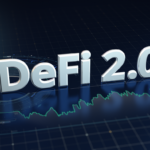Cryptocurrency has evolved fast—and now, a smarter, more sustainable movement is taking shape: DeFi 2.0. Unlike the earlier wave of DeFi protocols that focused on high rewards and rapid adoption, DeFi 2.0 is designed to serve real users with practical tools, long-term stability, and stronger control over financial systems.
What’s Changed Since DeFi 1.0?
DeFi 1.0 gave us access to decentralized exchanges, lending platforms, and yield farming. It removed middlemen and handed power to the user. But it wasn’t perfect. Many platforms relied too heavily on token incentives, and users often faced issues like:
-
Impermanent loss
-
High fees during network congestion
-
Fragile liquidity dependent on short-term participants
These challenges slowed DeFi adoption and highlighted the need for smarter systems.
How DeFi 2.0 Solves the Problem
DeFi 2.0 protocols aim to be more efficient, resilient, and user-centric. Here’s how:
✅ Protocol-Owned Liquidity (POL)
Rather than depending on users to supply liquidity, projects like OlympusDAO introduced the concept of protocol-owned liquidity. This means platforms control their funds, improving stability and reducing volatility.
✅ Smarter Tokenomics
Instead of flooding the market with token rewards, DeFi 2.0 focuses on sustainable incentives. The goal is to reward genuine participation, not just speculative farming.
✅ Community-Led Governance
With better DAO (Decentralized Autonomous Organization) models, users have more power. Governance is shifting from a few developers to larger communities that vote on real decisions.
✅ User-Friendly Tools
Interfaces are becoming easier to use, with automation, analytics, and built-in insurance to protect user funds. The aim is to bring DeFi to everyday users, not just tech-savvy traders.
Notable Projects Leading DeFi 2.0
-
OlympusDAO – Creator of the POL model and bonding mechanics
-
Frax Finance – Innovating stablecoins with algorithmic and collateralized elements
-
Tokemak – Optimizing liquidity direction across protocols
-
Alchemix – Offering self-repaying loans using future yield
The Impact on Users
DeFi 2.0 is lowering the barrier to entry. Even newcomers can now interact with DeFi safely:
-
Reduced risk of sudden losses
-
Clearer user interfaces
-
More transparency in how protocols operate
And for developers, these systems offer models that are easier to maintain and scale.
Conclusion
In essence, DeFi 2.0 is about building a decentralized financial future that actually works—for developers, for investors, and for everyday users. It takes the lessons learned from early DeFi experiments and turns them into tools that are smarter, safer, and designed for the long haul.

